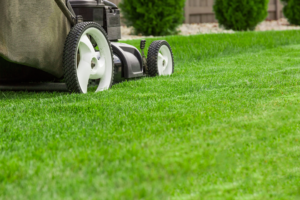Lawn Care And Maintenance
Proper lawn care begins in the spring. To avoid summer problems, start focusing on your lawn care in March. The best prevention is a lawn that is healthy and thick. It will ward off weeds, insects and diseases better than any other measure.
Aerate and Fertilize
In the Rocky Mountain region, most lawns are comprised of cool-season grasses. For cool-season grasses (Kentucky bluegrasses, fescues), it’s best to aerate and fertilize the lawn before the grass gets going in April. If you choose to fertilize only once, feed in the fall; if twice, then in spring and fall. If you desire a green lawn from spring to fall, then fertilize four times per year, early spring, late spring, late summer and mid-fall.
Mowing
 By ensuring that your lawn mower blades are always sharp, you will make certain that your grass is cleanly cut, not shredded. This will help stave off diseases. The lawn should be mowed when it reaches a height of 3 to 4 inches. Leaving grass clippings on the lawn recycles nutrients into the soil. However, clumps of clippings should not be left on the surface of the lawn.
By ensuring that your lawn mower blades are always sharp, you will make certain that your grass is cleanly cut, not shredded. This will help stave off diseases. The lawn should be mowed when it reaches a height of 3 to 4 inches. Leaving grass clippings on the lawn recycles nutrients into the soil. However, clumps of clippings should not be left on the surface of the lawn.
Watch Your Lawn for Symptoms of Problems.
Although you take every precaution, you may still experience summer problems. Here are some common ones and ways to handle them. Weeds: For information on management of Grassy Weeds: www.ext.colostate.edu/pubs/garden/03101.html
Other strange patterns or brown-yellow spots: It’s extremely difficult to diagnose whether a lawn’s problem is a disease, an insect, a certain weed or the next-door neighbor’s dog visiting your lawn. Take a 2×2-inch plug of affected grass and soil to your County Cooperative Extension office, and ask the staff to identify the problem and the treatment. Examine the entire lawn so you can describe any unusual patterns or colors. Take pictures with a digital camera if available.
